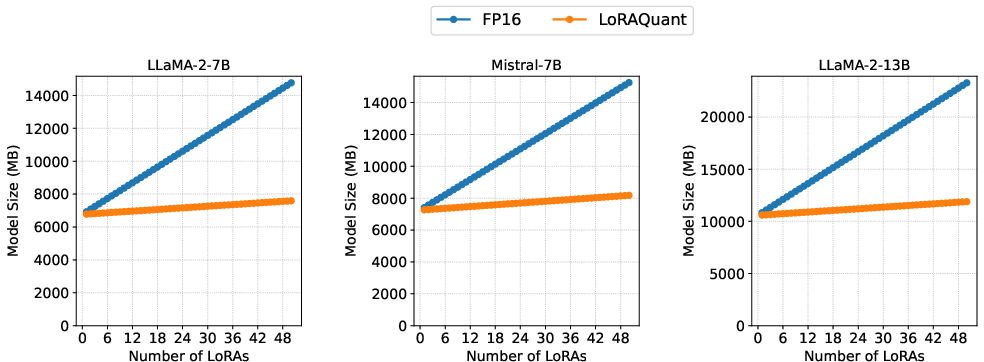- The paper introduces SVD-based splitting of LoRA adapters to concentrate key information and enable aggressive ultra-low bit quantization.
- It employs mixed-precision quantization with gradient-based optimization to preserve performance across various LLM benchmarks.
- The approach enhances memory efficiency in multi-tenant serving scenarios, facilitating scalable and cost-effective LLM customization.
LoRAQuant: Mixed-Precision Quantization of LoRA to Ultra-Low Bits
Introduction and Motivation
The proliferation of Low-Rank Adaptation (LoRA) for parameter-efficient fine-tuning of LLMs has enabled scalable customization for diverse tasks and users. However, the aggregate memory footprint of simultaneously loaded LoRA adapters becomes a bottleneck in multi-tenant LLM serving scenarios. Existing quantization methods, while effective for full model weights, are suboptimal for LoRA due to its unique low-rank structure and the need for ultra-low bitwidth quantization. LoRAQuant addresses this by introducing a mixed-precision post-training quantization scheme specifically tailored for LoRA adapters, leveraging SVD-based reparameterization to concentrate information and enable aggressive bitwidth reduction without significant performance degradation.
Methodology
SVD-Based Sub-LoRA Splitting
LoRAQuant decomposes each LoRA adapter BA into two sub-adapters via truncated SVD:
BA=USV⊤
The reparameterization B′=US1/2, A′=S1/2V⊤ ensures that singular values rank the importance of each component. The top-h singular directions (determined dynamically by a coverage ratio ρ) are assigned to a high-precision sub-LoRA, while the remaining r−h directions are relegated to a low-precision (1-bit) sub-LoRA.

Figure 1: QuantizeLora algorithm overview, illustrating SVD-based splitting and mixed-precision quantization of LoRA adapters.
Mixed-Precision Quantization
- High-Precision Sub-LoRA: Quantized using RTN (Round-To-Nearest) at 2 or 3 bits per weight, with group-wise scaling and zero-point offsets.
- Low-Precision Sub-LoRA: Quantized using sign-based binarization ({−S,+S}), with scaling factors minimizing Frobenius norm reconstruction error.
Gradient-based optimization (using STE) is applied to each singular dimension to minimize quantization error prior to discretization, further improving representational fidelity.
Dynamic Bitwidth Allocation
The selection of h (number of high-precision components) is governed by the ratio ρ of total singular value energy preserved:
∑i=1rsi2∑i=1hsi2≥ρ
This adaptive strategy ensures that layers requiring greater representational capacity receive more precision, outperforming static or norm-based allocation.

Figure 2: Comparison of h selection strategies, demonstrating superior performance of dynamic ratio-based allocation over static approaches.
Experimental Results
Benchmarks and Setup
LoRAQuant is evaluated on LLaMA 2-7B, LLaMA 2-13B, and Mistral 7B across GSM8K (math reasoning), MATH, HumanEval (code generation), and XSum (summarization). LoRA adapters are trained per task, and quantization is applied post-training. Metrics include pass@1 accuracy for math/code and ROUGE-L for summarization.
LoRAQuant achieves competitive or superior task performance compared to state-of-the-art quantization baselines (GPTQ, PB-LLM, BiLLM) at substantially lower average bitwidths (often <2 bits/parameter). Notably, binary quantization and 1-bit RTN collapse performance, while LoRAQuant maintains high accuracy even under extreme compression.
- LLaMA 2-7B, GSM8K: LoRAQuant ([email protected]$) achieves 51.25% accuracy at 1.65 bits, outperforming PB-LLM and BiLLM at higher bitwidths.
- Mistral 7B, HumanEval: LoRAQuant ([email protected]$) reaches 39.63% at 1.97 bits, matching or exceeding baselines.
Ablation and Analysis

Figure 3: Ablation paper on optimization and quantization, showing the necessity of both SVD-based splitting and gradient-based optimization for maximal performance.
Memory Efficiency

Figure 5: Memory usage scaling with number of loaded LoRAs, demonstrating LoRAQuant's substantial savings over FP16 as adapter count increases.
LoRAQuant's memory footprint grows sublinearly with the number of adapters, enabling practical multi-tenant LLM serving on resource-constrained hardware.
Implementation Considerations
- Computational Overhead: SVD and per-dimension optimization are efficient due to low LoRA rank (r=16), with optimization converging in ∼100 steps.
- Scalability: Each LoRA is quantized independently, facilitating parallelization and deployment at scale.
- Integration: LoRAQuant is compatible with standard QLoRA pipelines; base models can be quantized separately.
- Limitations: The method is specific to low-rank adapters; extension to full-rank matrices would require additional truncation and is nontrivial.
Implications and Future Directions
LoRAQuant enables aggressive memory reduction for multi-adapter LLM customization without sacrificing task performance, making it suitable for large-scale, multi-tenant deployments. The SVD-based mixed-precision paradigm may inspire analogous approaches for other structured model components. Future work could explore generalization to full model weights, integration with hardware-aware quantization, and commercial-scale validation.
Conclusion
LoRAQuant introduces a principled, SVD-driven mixed-precision quantization framework for LoRA adapters, achieving ultra-low bitwidths with minimal performance loss. Through dynamic allocation, specialized quantization, and efficient optimization, it sets a new standard for memory-efficient LLM customization. The approach is robust, scalable, and readily applicable to real-world multi-adapter serving scenarios, with potential for further extension and integration in the broader quantization landscape.




